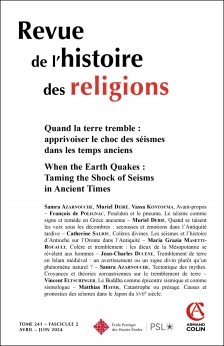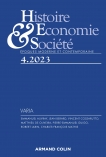
REVUE DE L'HISTOIRE DES RELIGIONS (2/2024)
Pour acheter ce numéro, contactez-nous
Recevez les numéros de l'année en cours et accédez à l'intégralité des articles en ligne.
Si le bruit du tremblement de terre qui toucha Nicomédie le 24 août 358 est parvenu jusqu’à nous, c’est grâce aux mots de ceux qui l’ont raconté, chacun dans un genre différent : l’historien Ammien Marcellin, le rhéteur Libanios et le poète et théologien Éphrem de Nisibe, rarement mis en parallèle. Aucun des trois n’était présent sur les lieux, mais ils ont chacun essayé de rendre compte des émotions qu’avait suscitées la catastrophe et de provoquer à leur tour les émotions de leur public par le pouvoir de la rhétorique. Ils ont tissé de ténus fils explicatifs pour comprendre les liens entre les dieux (unique des chrétiens ou multiples des religions traditionnelles) et les secousses telluriques et mouvements des eaux.
If the sound of the earthquake that struck Nicomedia on August 24, 358 has reached us, it is thanks to the words of those who recounted it, each in a different genre : the historian Ammianus Marcellinus, the rhetorician Libanius and the poet and theologian Ephrem of Nisibis, who are rarely placed side by side. None of the three was present at the scene, but each of them tried to capture the emotions aroused by the catastrophe, and in turn to arouse the emotions of their audience through the power of rhetoric. They spun tenuous explanatory threads to understand the links between the gods (single God of the Christians or multiple gods of traditional religions) and telluric tremors and water movements.

